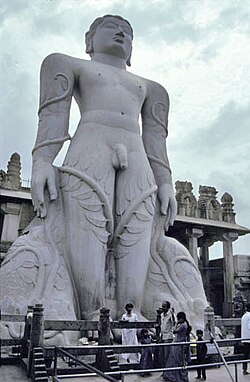Temples of Karnataka: Difference between revisions
cp image caption |
→Architecture: cpedit |
||
| Line 72: | Line 72: | ||
==Architecture== |
==Architecture== |
||
[[Image:Nandi-atop-chamundi-hills.jpg|250px|thumb|right|An idol of Nandi in [[Mysore]], a common sculpture found in any temple of |
[[Image:Nandi-atop-chamundi-hills.jpg|250px|thumb|right|An idol of Nandi in [[Mysore]], a common sculpture found in any temple of Karnataka]] |
||
[[Image:Bhumija towers on minor shrines in Chennakeshava Temple at Belur.jpg|left|thumb|250px|Miniature shrines with ''Bhumija'' towers, [[Belur |
[[Image:Bhumija towers on minor shrines in Chennakeshava Temple at Belur.jpg|left|thumb|250px|Miniature shrines with ''Bhumija'' towers, [[Belur]] |
||
[[File:Pattadakal Virupaksha Temple.jpg|right|thumb|250px|Virupaksha temple, [[Pattadakal]]lu]] |
[[File:Pattadakal Virupaksha Temple.jpg|right|thumb|250px|Virupaksha temple, [[Pattadakal]]lu]] |
||
[[Image:Chennakeshava Temple at Belur.jpg|right|thumb|250px|Chennakeshava Temple, [[Belur]]]] |
[[Image:Chennakeshava Temple at Belur.jpg|right|thumb|250px|Chennakeshava Temple, [[Belur]]]] |
||
Revision as of 11:40, 30 August 2014
Temples of the Indian State of Karnataka illustrate the varieties of architecture prevalent in various periods. The architectural designs have found a distinguished place in forming a true atmosphere of devotion for spiritual attainment.
Most famous temples of Karnataka



- Shri Manjunatheshwara Temple, Kadri, Mangalore
- Shri Manjunatheshwara Temple, Dharmastala

- Shri Mahalingeshwara Temple, Puttur
- Mahatobar Shri Siddi Vinayaka Temple, Idagunji
- Shri Mahaganapathi Temple, Sharavu
- Shri Mangaladevi Temple, Mangalore
- Shri Subramanyeshwara Temple, Kukke Subramanya
- Shri Rajarajeswari Temple, Polali
- Shri Annapurneshwari Temple, Horanadu
- Shri Mukambika Temple, Kolluru
- Sri Brahmi Durgaparameshwari Temple, Kamalashile
- Shri Durga Parameshwari Temple, Kateelu
- Anegudde Shri Vinayaka Temple, Anegudde
- Shri Chamundeshwari Temple, Mysore
- Shri Dharmarayaswamy Temple Bangalore
- Sidhaganga Math, Tumkur
- Sidharudha Math, Hubli
- Padutirupathi Venkataramana Temple, Karkala
- Renuka Yallamma Temple, Saundatti
- Sri Narasimha Saraswati Swami, an incarnation of Dattatreya.
Dattatreya Temple, Ganagapura
- Marikamba Temple, Sirsi
- Chandragiri Hill, Shravanabelagola
- Mahadev Temple, Gokarna
- Mahabaleshwar Temple, Gokarna
- Murdeshwara Temple
- Krishna Temple, Udupi
- Kanaka guru Peetha, Kaginele
- Varur - Navagraha Kshetra, Hubballi
- Sringeri Sharada Peetham, Sringeri
Architecture

[[Image:Bhumija towers on minor shrines in Chennakeshava Temple at Belur.jpg|left|thumb|250px|Miniature shrines with Bhumija towers, Belur [[File:Pattadakal Virupaksha Temple.jpg|right|thumb|250px|Virupaksha temple, Pattadakallu]]

Temples of Karnataka feature many architectural styles:
- Hoysala Architecture
- Badami Chalukya Architecture
- Vijayanagara architecture
- Dravidian Architecture
- Western Chalukya Architecture
- Badami Cave Temples
- Rashtrakuta style
- Ganga Architecture
Most temples have some features in common:
- Nandi (bull) sculpted in black stone at the entrance of a temple is symbolic of the start of the divine place and temple area.
- Pushkarani (a stepped bathing area), with neatly sculpted steps, for temple devotees travelling from far places to take a breather and cleanse. The pushkarani is typically a square shaped construction which has arrangements to keep the water flowing so it does not stagnate.
- Gopura are ornate monumental towers which mark the entrance to the temple.
- Garbhagudi (garbha meaning womb in Sanskrit/Kannada) is the inner sanctum, which can be of various size and shapes according to the architecture. Garbhagudi may be placed on an elevated place on a stone foundation. Artists may find a place to practice and display devotional sangeetha (music) and naatya (dancing).
- Vigraha is an image of the God, typically a black stone lingam, inside the inner sanctum (garbhagudi).
Normally the oldest temples are built on hilltops, where people view God being placed on top of all in the midst of Prakṛti (nature). The steps to reach the top are carefully carved on rocky hills as most of the hard stone mountains rocks contain water. Shiva Gange at Therhalli is one such example.
Other temples situated on hills include Chamundeshwari Hills, Mahadeshwara Hills, Biligiriranga Hills and Kodachadri Hills.
Temples and Practices
Some temples of Dakshina Kannada have the practice of not allowing ordinary clothing to be worn inside. People can drape a cloth over, or wear a Lungi. This practise is especially found in the temples in Dakshina Kannada, which lies between the Western Ghats and the Arabian Sea. This is a very popular temple as the climate is suitable for visiting all year long. Kollur, Kukke, Dharmasthala, Sringeri, Horanadu, Karkala, Murudeshwara and Gokarna are some other famous temples known for devotees thronging to them all through the year.
Many temples in Udupi represent the Dvaita philosophy, and are mostly run by priests of the Ashta Matha monasteries. The Sri Krishna temple, also in Udupi, features the Kanakana kindi or Kanaka's Window, a small peephole in the wall of the temple through which a statue of the great Indian saint Kanaka Dasa may be viewed.
Temples in Sringeri represent the Advaita Vedanta philosophy of Adi Shankara. Being one of oldest institutions of Sanskrit learning, Sringeri Shaarada Peetha is seen as abode of Saraswati, the goddess of learning, and holds a very prominent place in the history of learning and in the hearts of Kannadigas.
North Karnataka temples represent the old glory of long ago kingdoms, with some rituals still practised. Many of the magnificently sculpted temples include shaasanas (inscriptions) which depict various important historical periods.
